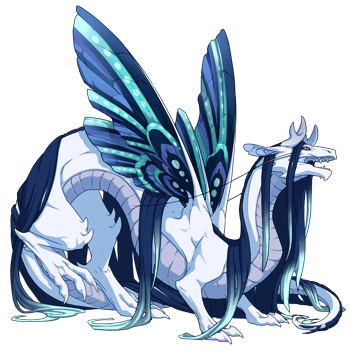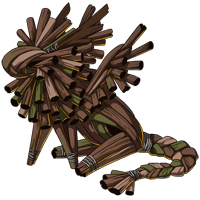

SolsticeVeilspun
(#65981062)
Level 1 Veilspun
Click or tap to view this dragon in Predict Morphology.
Energy: 0/50

Expand the dragon details section.
Collapse the dragon details section.
Personal Style

Ancient dragons cannot wear apparel.
Skin
Scene
Measurements
Length
0.43 m
Wingspan
0.79 m
Weight
0.94 kg
Genetics
Ice
Basic
Basic
Splash
Vivid (Veilspun)
Vivid (Veilspun)
Blue
Basic
Basic
Hatchday
Breed
Eye Type
Level 1 Veilspun
EXP: 0 / 245


STR
5
AGI
6
DEF
5
QCK
8
INT
8
VIT
5
MND
8
Biography
"Christmas Stars"
Born on Dec. 21, 2020 (during the longest night of the year in the Northern Hemisphere: Winter Solstice)

Born on Dec. 21, 2020 (during the longest night of the year in the Northern Hemisphere: Winter Solstice)
I am a very special hatchling!
I was born on the December Solstice - Dec. 21, 2020,
During a rare conjunction of the planets Jupiter and Saturn, and
During the Ursids Meteor Shower!
I was born on the December Solstice - Dec. 21, 2020,
During a rare conjunction of the planets Jupiter and Saturn, and
During the Ursids Meteor Shower!

December Solstice: Astronomically, solstice is the two moments in the year when the Sun’s apparent path is farthest north (summer solstice) or south (winter solstice) from Earth’s Equator. In the Northern Hemisphere the summer solstice occurs on June 20 or 21 and the winter solstice on December 21 or 22. In the Southern Hemisphere, the seasons are exactly reversed. The shortest day/longest night occurs at the winter solstice (called “Midwinter”), while the longest day/shortest night occurs at the summer solstice (called Midsummer”). For 2019 in the Northern Hemisphere, winter solstice occurred on Saturday, December 21 at 11:19pm EST.
Historically, the winter solstice, was a time to feast and make merry. For example, pre-Christian Scandinavians, Celts and Germanic peoples lit fires and burned Yule logs as a symbolic means of conquering darkness, banishing evil spirits that lurked in the darkness and bringing luck and good fortune for the coming year. Cattle and other animals were slaughtered followed by feasting on what was the last fresh meat for several months. Pre-Islamic Iranians celebrated “Yalda” on winter solstice. This feast heralds the birth of the ancient sun god Mithra and his triumph over darkness. Zoroastrians believed that evil spirits wandered the Earth and the forces of the destructive spirit Ahriman were strongest on winter solstice. To foil these evil spirits they gathered together all night for feasting and sharing poetry, songs and stories.
Even today during this literally darkest time of the year, we practice ways to banish evil spirits and welcome good luck by:
1) Staying up most of the night with family and friends eating, talking and sharing stories
(televised or live), and songs/music and games in order to avoid any brushes with dark entities.
2) Lighting candles, fireplaces, bonfires or even electric lights to banish darkness.
3) Decorating our homes with symbols of life -- plants and greenery especially evergreens.
(Combine with 2 above and you have the Christmas tree and wreaths)
4) Showing our gratitude for the people around us with small gifts.
5) Weakening or banishing evil by doing kind and selfless deeds for others.
Rare Conjunction of Jupiter and Saturn. In astronomy, "conjunctions" are when two planets or other objects in space appear to be close to each other as observed from Earth, even though they are really millions of miles/kilometers apart. "Great conjunctions" occur when Jupiter and Saturn, which are the two biggest planets in our solar system, appear to be close in space as observed from Earth. Though the two planets appeared close together on December 21, 2020, they were actually 456 million miles (734 million km) apart. Saturn was nearly twice as far away as Jupiter. This year is particularly special because the two planets appeared to separated by just one-fifth the diameter of a full moon – or 0.1 degrees. In fact, they were so close they looked like they were a bright double planet.
Jupiter-Saturn conjunctions happen every 20 years. The last one was in the year 2000. But they are not all the same. The 2020 great conjunction of Jupiter and Saturn was the closest to Earth since 1623 (but that conjunction was too near the sun as was not observable from Earth) and the closest observable since 1226 - almost 800 years ago! 2020’s extra-close Jupiter-Saturn conjunction will not be matched again until the Jupiter-Saturn conjunction of March 15, 2080!
The two planets have been moving closer to each other for much of 2020. They looked like two points of light in the sky. Saturn, which is farther from Earth, was the fainter one. Weather permitting, it was observable from anywhere on Earth, although it was more difficult to see in high northern latitudes. The best viewing conditions were near the equator looking towards the west. The best time for viewing was between dusk and 15 to 20 minutes after dark. The maximum conjunction occurred at 1:20 p.m. ET on Dec. 21, 2020, but it was not visible to the naked eye during daylight, although North Americans were able to see the conjunction in the early night of Dec. 21, weather permitting. While the maximum conjunction was on Dec. 21, 2020, Jupiter and Saturn will still appear to be closer than the diameter of a full moon from Dec. 16 to Dec. 25, 2020. You will be able to tell you are looking at the conjunction because unlike the stars which twinkle, their light will shine steadily and brightly and form a “Christmas Star, similar to the star of Bethlehem.”
Ursids Meteor Shower. The Ursids is a minor meteor shower producing about 5-10 meteors per hour. It is produced by dust grains left behind by the comet Tuttle, which was first discovered in 1790. The shower runs annually from December 17-25. It peaked in December 2020 on the the night of the 21st and morning of the 22nd. Meteors radiated from the constellation Ursa Minor, but could appear anywhere in the night sky.
Historically, the winter solstice, was a time to feast and make merry. For example, pre-Christian Scandinavians, Celts and Germanic peoples lit fires and burned Yule logs as a symbolic means of conquering darkness, banishing evil spirits that lurked in the darkness and bringing luck and good fortune for the coming year. Cattle and other animals were slaughtered followed by feasting on what was the last fresh meat for several months. Pre-Islamic Iranians celebrated “Yalda” on winter solstice. This feast heralds the birth of the ancient sun god Mithra and his triumph over darkness. Zoroastrians believed that evil spirits wandered the Earth and the forces of the destructive spirit Ahriman were strongest on winter solstice. To foil these evil spirits they gathered together all night for feasting and sharing poetry, songs and stories.
Even today during this literally darkest time of the year, we practice ways to banish evil spirits and welcome good luck by:
1) Staying up most of the night with family and friends eating, talking and sharing stories
(televised or live), and songs/music and games in order to avoid any brushes with dark entities.
2) Lighting candles, fireplaces, bonfires or even electric lights to banish darkness.
3) Decorating our homes with symbols of life -- plants and greenery especially evergreens.
(Combine with 2 above and you have the Christmas tree and wreaths)
4) Showing our gratitude for the people around us with small gifts.
5) Weakening or banishing evil by doing kind and selfless deeds for others.
Rare Conjunction of Jupiter and Saturn. In astronomy, "conjunctions" are when two planets or other objects in space appear to be close to each other as observed from Earth, even though they are really millions of miles/kilometers apart. "Great conjunctions" occur when Jupiter and Saturn, which are the two biggest planets in our solar system, appear to be close in space as observed from Earth. Though the two planets appeared close together on December 21, 2020, they were actually 456 million miles (734 million km) apart. Saturn was nearly twice as far away as Jupiter. This year is particularly special because the two planets appeared to separated by just one-fifth the diameter of a full moon – or 0.1 degrees. In fact, they were so close they looked like they were a bright double planet.
Jupiter-Saturn conjunctions happen every 20 years. The last one was in the year 2000. But they are not all the same. The 2020 great conjunction of Jupiter and Saturn was the closest to Earth since 1623 (but that conjunction was too near the sun as was not observable from Earth) and the closest observable since 1226 - almost 800 years ago! 2020’s extra-close Jupiter-Saturn conjunction will not be matched again until the Jupiter-Saturn conjunction of March 15, 2080!
The two planets have been moving closer to each other for much of 2020. They looked like two points of light in the sky. Saturn, which is farther from Earth, was the fainter one. Weather permitting, it was observable from anywhere on Earth, although it was more difficult to see in high northern latitudes. The best viewing conditions were near the equator looking towards the west. The best time for viewing was between dusk and 15 to 20 minutes after dark. The maximum conjunction occurred at 1:20 p.m. ET on Dec. 21, 2020, but it was not visible to the naked eye during daylight, although North Americans were able to see the conjunction in the early night of Dec. 21, weather permitting. While the maximum conjunction was on Dec. 21, 2020, Jupiter and Saturn will still appear to be closer than the diameter of a full moon from Dec. 16 to Dec. 25, 2020. You will be able to tell you are looking at the conjunction because unlike the stars which twinkle, their light will shine steadily and brightly and form a “Christmas Star, similar to the star of Bethlehem.”
Ursids Meteor Shower. The Ursids is a minor meteor shower producing about 5-10 meteors per hour. It is produced by dust grains left behind by the comet Tuttle, which was first discovered in 1790. The shower runs annually from December 17-25. It peaked in December 2020 on the the night of the 21st and morning of the 22nd. Meteors radiated from the constellation Ursa Minor, but could appear anywhere in the night sky.
Happy Solstice and happy sky watching!
Sources
https://www.britannica.com/science/solstice
https://www.bbc.co.uk/religion/religions/paganism/holydays/wintersolstice.shtml
https://www.mentalfloss.com/article/72659/10-things-you-probably-didnt-know-about-winter-solstice
https://earthsky.org/astronomy-essentials/great-jupiter-saturn-conjunction-dec-21-2020#:~:text=Jupiter%2DSaturn%20conjunctions%20happen%20every,the%20closest%20observable%20since%201226!
https://www.usatoday.com/story/news/nation/2020/12/03/2020-great-conjunction-rare-christmas-star-jupiter-saturn-align/3808185001/
http://www.seasky.org/astronomy/astronomy-calendar-current.html
Image: https://www.kvue.com/article/weather/christmas-star-jupiter-saturn-rare-double-planet-december-solstice/269-34b0330d-2f72-4ac5-82a4-0dd966d445d7
https://www.britannica.com/science/solstice
https://www.bbc.co.uk/religion/religions/paganism/holydays/wintersolstice.shtml
https://www.mentalfloss.com/article/72659/10-things-you-probably-didnt-know-about-winter-solstice
https://earthsky.org/astronomy-essentials/great-jupiter-saturn-conjunction-dec-21-2020#:~:text=Jupiter%2DSaturn%20conjunctions%20happen%20every,the%20closest%20observable%20since%201226!
https://www.usatoday.com/story/news/nation/2020/12/03/2020-great-conjunction-rare-christmas-star-jupiter-saturn-align/3808185001/
http://www.seasky.org/astronomy/astronomy-calendar-current.html
Image: https://www.kvue.com/article/weather/christmas-star-jupiter-saturn-rare-double-planet-december-solstice/269-34b0330d-2f72-4ac5-82a4-0dd966d445d7
Click or tap a food type to individually feed this dragon only. The other dragons in your lair will not have their energy replenished.
Insect stocks are currently depleted.
Meat stocks are currently depleted.
Seafood stocks are currently depleted.
Plant stocks are currently depleted.
Exalting SolsticeVeilspun to the service of the Arcanist will remove them from your lair forever. They will leave behind a small sum of riches that they have accumulated. This action is irreversible.
Do you wish to continue?
- Names must be longer than 2 characters.
- Names must be no longer than 16 characters.
- Names can only contain letters.
- Names must be no longer than 16 characters.
- Names can only contain letters.










